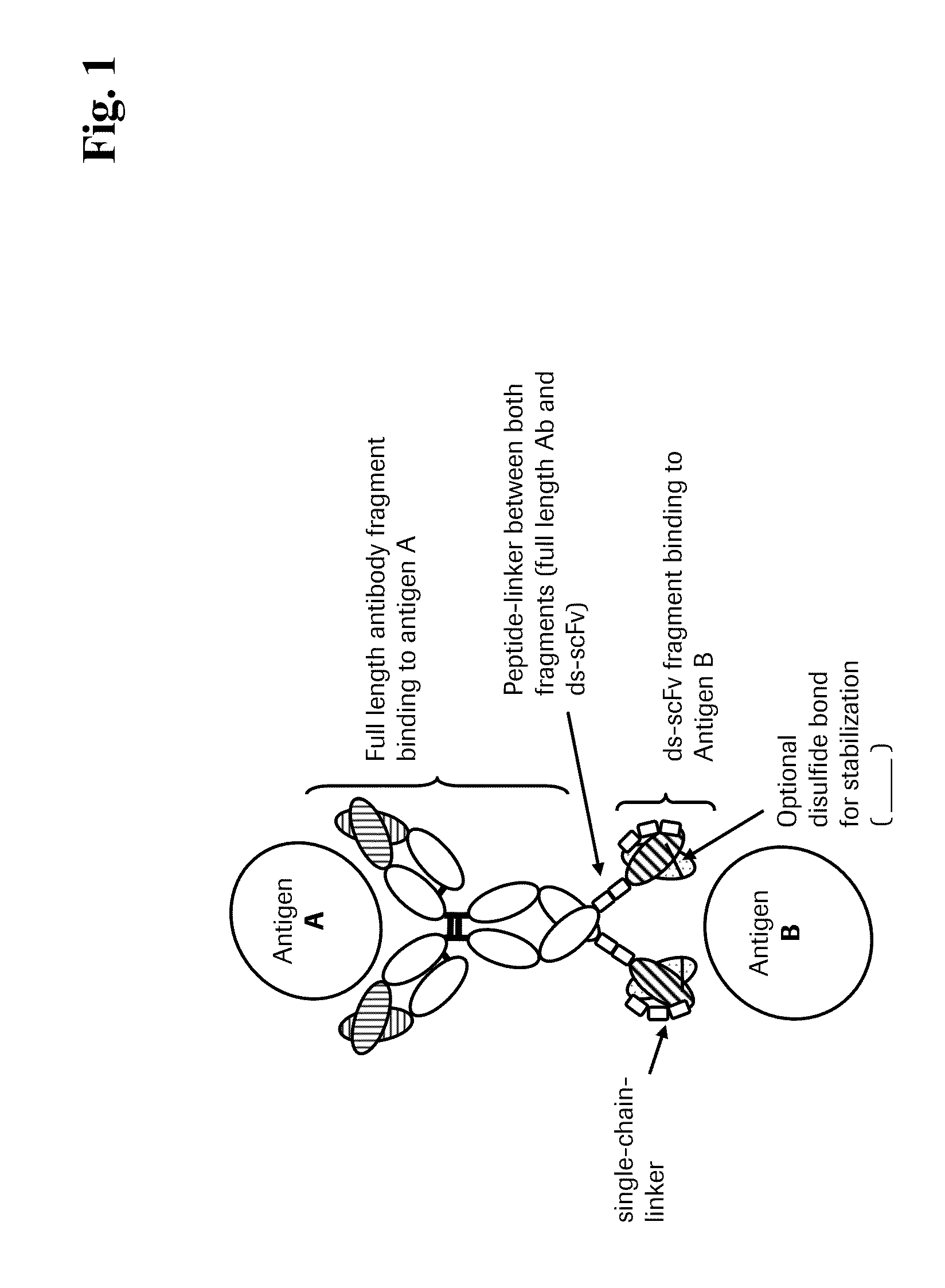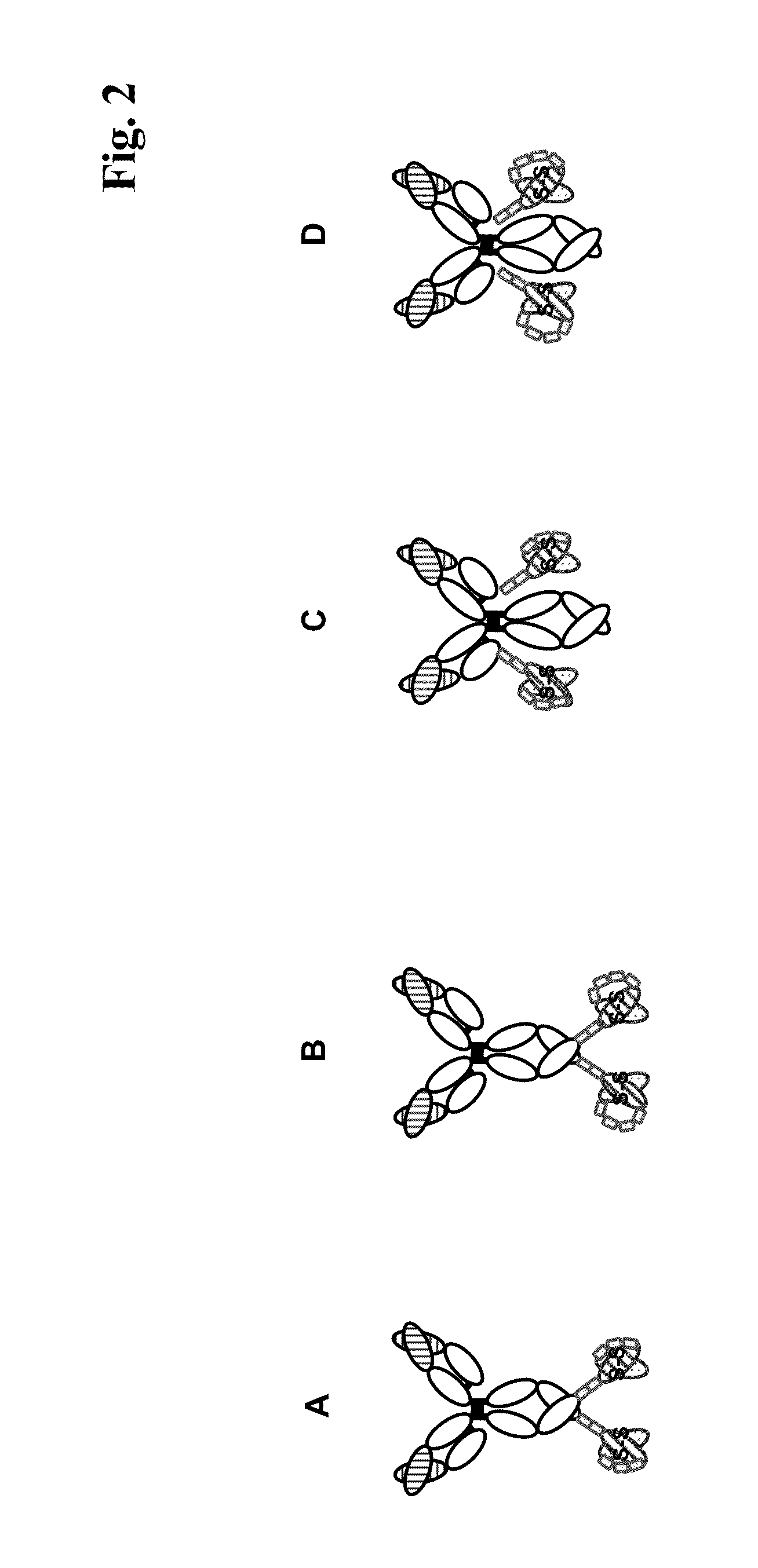Bispecific Anti-egfr/Anti-igf-1r antibodies
a technology of igf-1r and egfr, which is applied in the field of igf-1r-specific antibodies, can solve the problems of poor prognosis of patients, induction of immune responses, and overexpression of egfr
- Summary
- Abstract
- Description
- Claims
- Application Information
AI Technical Summary
Benefits of technology
Problems solved by technology
Method used
Image
Examples
example 1
Expression & Purification of Bispecific Antibody XGFR1 Molecules
[0341]Light and heavy chains of the corresponding bispecific antibodies were constructed in expression vectors carrying pro- and eukaryotic selection markers. These plasmids were amplified in E. coli, purified, and subsequently transfected for transient expression of recombinant proteins in HEK293F cells (utilizing Invitrogen's freesyle system). After 7 days, HEK 293 cell supernatants were harvested and purified by protein A and size exclusion chromatography. Homogeneity of all bispecific antibody constructs was confirmed by SDS-PAGE under non reducing and reducing conditions. Under reducing conditions (FIG. 2a), polypeptide chains carrying C- and N-terminal scFv fusions showed upon SDS-PAGE apparent molecular sizes analogous to the calculated molecular weights. Expression levels of all constructs were analysed by Protein A HPLC and were similar to expression yields of ‘standard’ IgGs, or in some cases somewhat lower. ...
example 2
Stability of Bispecific Antibody XGFR1 Molecules in vitro
HP-Size Exclusion Chromatography Analysis was Performed
[0347]The aggregate content of bispecific antibody samples was analyzed by high-performance SEC on an UltiMate 3000 HPLC system (Dionex) using a Superdex 200 analytical size-exclusion column (GE Healthcare, Sweden) in 200 mM KH2PO4, 250 mM KCl, pH 7.0 running buffer at 25° C. 25 μg protein were injected on the column at a flow rate of 0.5 ml / min and eluted isocratic over 50 minutes. For stability analysis, concentrations of 0.1 mg / ml, 1 mg / ml and 5 mg / ml of purified proteins were prepared and incubated at 4° C., 37° C. and 40° C. for 7 or 28 days and then evaluated by high-performance SEC. The integrity of the amino acid backbone of reduced bispecific antibody light and heavy chains was verified by NanoElectrospray Q-TOF mass spectrometry after removal of N-glycans by enzymatic treatment with Peptide-N-Glycosidase F (Roche Molecular Biochemicals).
[0348]HP-Size exclusion c...
example 3
Simultanous Binding of Bispecific Antibody XGFR1Molecules to the RTKs EGFR and IGF1R
[0352]The binding of the scFv modules and of the Fvs retained in the IgG-module of the different bispecific antibody formats were compared to the binding of the ‘wildtype’ IgGs from which the binding modules and bispecific antibodies were derived. These analyses were carried out by applying Surface Plasmon Resonance (Biacore), as well as a cell-ELISA.
[0353]The binding properties bispecific anti-IGF-1R / anti-EGFR antibodies were analyzed by surface plasmon resonance (SPR) technology using a Biacore T100 instrument (Biacore AB, Uppsla). This system is well established for the study of molecule interactions. It allows a continuous real-time monitoring of ligand / analyte bindings and thus the determination of association rate constants (ka), dissociation rate constants (kd), and equilibrium constants (1(D) in various assay settings. SPR-technology is based on the measurement of the refractive index close ...
PUM
| Property | Measurement | Unit |
|---|---|---|
| Fraction | aaaaa | aaaaa |
| Mass | aaaaa | aaaaa |
| Mass | aaaaa | aaaaa |
Abstract
Description
Claims
Application Information
 Login to View More
Login to View More - R&D
- Intellectual Property
- Life Sciences
- Materials
- Tech Scout
- Unparalleled Data Quality
- Higher Quality Content
- 60% Fewer Hallucinations
Browse by: Latest US Patents, China's latest patents, Technical Efficacy Thesaurus, Application Domain, Technology Topic, Popular Technical Reports.
© 2025 PatSnap. All rights reserved.Legal|Privacy policy|Modern Slavery Act Transparency Statement|Sitemap|About US| Contact US: help@patsnap.com



